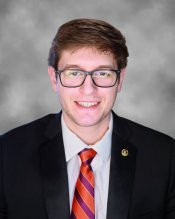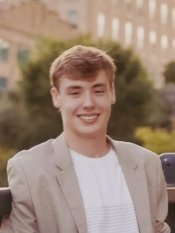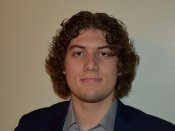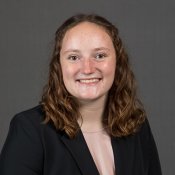Selections for the second class of Future Innovators of America Fellowships have been announced by the Jerome J. Lohr College of Engineering.
The seven recipients and the department which selected them are:
- Jakob Fossen and Jax Wysong, both mathematics and statistics;
- Lucas Gervais, civil engineering;
- Carter Waggoner and Dominic Winstead, both mechanical engineering;
- Magdalene Hoff and Myranda Hentges, both ag engineering.
Recipients are awarded $5,000 with $4,500 as a stipend and $500 to cover the cost of lab supplies or travel to disseminate the results of their project.
The fellowships were created to provide unique research opportunities for undergraduate students in the college. Any student is eligible to apply as long as they are attending full time and have a GPA of 3.0 or higher. Application deadline was Nov. 5.
Students worked with a potential project mentor, who must be a faculty or research staff member, to develop and submit a research plan that entails learning by doing.
Projects that 2022-23 recipients will focus on are:

• Wysong, a senior physics major from Hills, Minnesota, will work under associate professor Jung-Han Kimn to investigate “ghosts” in computational partial differential equation solutions.
In the field of high-level physics equations, a system is said to contain a ghost when it has a term with negative kinetic energy. In this work, he investigates a system of two scalar fields, for example, X and Y. The field X is associated with a positive kinetic energy term and the field Y is associated with a negative kinetic energy term, which forces the system to contain a ghost.
Generally, when systems are ghost-ridden, they are physically unstable and, therefore, meaningless for further investigation. However, recent work has shown that some ghost-ridden systems are stable. His work aims to computationally implement a numerical method that can solve this simple ghost system of scalar fields to determine if it is physically stable or not.
“Once we have successful code for this work, we will implement it into different scenarios,” Wysong said.

• Fossen, a senior from Lakeville, Minnesota, is working under professor Xijin Ge, to assist with the development of an iDEP genomics app.
The project goal is to create an artificial intelligence that will identify and classify cancer-related genomics data.
The AI is supposed to create detailed summaries of the experiments to understand the meaning and then use special techniques to group similar experiments together. This helps uncover hidden patterns and connections in the experiment descriptions.
The expected outcome of this research is to create a tool that will identify and classify cancer-related genomics experiment descriptions from a vast collection of datasets.
“My goal is to have the project completed by the end of the semester, however, it could go a little into the following semester since this project is ambitious,” Fossen said.

• Gervais, a senior from Currie, Minnesota, will work under assistant professor Akram Jawdhari to test the mortar used to bond concrete and masonry blocks. The plan is to test various fiber-reinforced cementitious matrixes to normal force and shear force failure to determine superior strength.

• Waggoner, a senior mechanical engineering student from Rapid City, will work under the direction of associate professor Todd Letcher to design a bucket wheel excavation system for future lunar missions.
At a NASA testing facility in Huntsville, Alabama, June 3-5, the SDSU Break the Ice team and its three rovers will compete against other aerospace companies and universities. The team hopes to secure a top-two placement in the competition to receive the $1 million top prize or the $500,000 runner-up prize.
Waggoner is a repeat selection from 2023, when he worked under Letcher to test the strength of 3D printed parts.
• Winstead, a junior from Elysian, Minnesota, will work under the direction of assistant professor Saikat Basu to study particle transport in nasal pathways.
Specifically, the project aims to derive a scaling argument to characterize intra-airway particle dynamics and specifically study the effects of gravity on the particle distribution. Understanding particle transport in these various gravitational scenarios is crucial for understanding airborne infections as well as for the delivery of targeted drugs in areas like outer space. The project is set to be finished by December.

• Hoff, a senior from Gillette, Wyoming, will work under the direction of professor and Department Head Muthu Muthukumarappan to study the effectiveness of magnetic-activated carbon from crop residue with the goal of absorbing pollutants in wastewater from meat processing facilities. Specifically, Hoff will attempt to produce magnetic-activated carbon from crop residues such as corn stover and soybean residue.

Magnetic-activated carbon has been created from nonrenewable precursors, but that is relatively costly and unfeasible for possible utilization of the materials in large-scale applications. Thus, research is being conducted worldwide to use alternative, abundant, renewable precursors for magnetic-activated carbons.Hoff is a repeat selection from 2023, when she worked on a project in this field as well
• Hentges, a senior from Lester Prairie, Minnesota, will work under the direction of assistant professor John McMaine to study tile drainage across eastern South Dakota.
Last year they worked with producers to sample tile drain outflow.
“We have run a statistical analysis comparing nitrate concentration from the tile outflow to precipitation and found that the location of the outlets was a higher factor than the precipitation amount itself. We are now focusing on running another statistical analysis comparing soil characteristics to nitrate concentrations.
“The sampling of the outlets is complete, and we will now be continuing the analysis of the remaining factors (crop growth, crop type, cropping history and nutrient management) and interpretation of the data. Hopefully, the data analysis will be completed in spring semester,” Hentges said.
After these risk factors are identified, areas at higher risk can be prioritized for nutrient loss mitigation.
- Contact:
- Telephone number: 605-688-4538
Republishing
You may republish SDSU News Center articles for free, online or in print. Questions? Contact us at sdsu.news@sdstate.edu or 605-688-6161.

